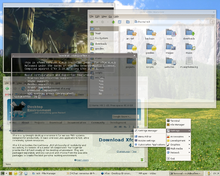Active window
In graphical user interfaces , where often several windows are displayed on the screen at the same time, the active or focused window is the one which receives keystrokes from the user , the rest is inactive. In principle, the method is independent of the mechanism of maximizing and minimizing the window and generally only applies to the windows that are not minimized - they are necessarily inactive.
Keyboard entries should only be forwarded to a specific window (or the application program it represents ). The support of the selection and the highlighting of the active window, for example by means of a different colored title bar, are the task of a window manager , which can also be integrated in the operating system.
The user can usually determine the active window both with the keyboard and with the mouse : For keyboard control there is usually a key combination to cycle through all windows ( Alt+ Tabunder Microsoft Windows , Ubuntu ), for mouse control different models are available depending on the window manager:
- The window under the mouse pointer is active ( focus-follows-mouse , X-Mouse ), or the window under which the mouse pointer was last located, if it is not over a window ( sloppy focus ).
- The active window can be set by clicking in the window or on the title bar (“click-to-focus”).
You can also activate the windows that are minimized in the window bar by clicking them - depending on the setting or process - or just moving the mouse pointer over them (e.g. when dragging and dropping ).
In addition, a window can receive program-controlled focus, for example when it is created after a program start, or as a pop-up window.
There are two models for dealing with active windows:
- The active window is automatically in the foreground, i.e. it covers all inactive windows ( autoraise , if necessary after a delay, so that when the mouse is hovered over it does not bring all overlined windows to the foreground).
- The active window stays where it is, the order of the transitions is not changed - a completely covered window can no longer be found in this setting (implemented in this way in AmigaOS ).
Active widget within windows
In most graphical user interfaces, windows, in particular dialog windows , are composed of control elements such as buttons or input fields . Analogous to windows, one of these can be focused on in order to receive keyboard input. Because widgets that are normally used with the mouse, such as buttons or checkboxes, are focused and then e.g. B. can be operated with the space bar , a use of the GUI without a mouse is possible.
The user can usually switch between the widgets with the Tab key in a sequence specified by the programmer (or with Shift+ Tabfor the reverse order) or, like between windows, using the mouse. The active widget is identified depending on the widget type, for example by framing the text of a button or a cursor in a text field.


